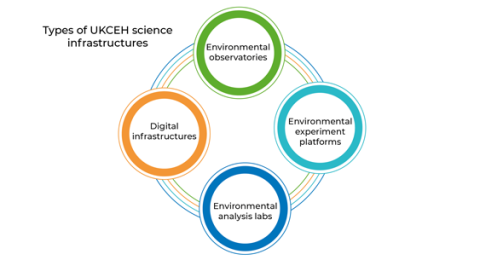UKCEH operates four classes of science infrastructure:


UKCEH operates four classes of science infrastructure:

To observe and measure UK environmental processes, status and change – within and across UK geographies, habitats and land uses.
Observation and measurement is important to track environmental processes, interconnection, status and change, where change is occurring at unprecedented scale and speed due to human actions. This observation needs to be UK-wide in coverage and sustained over time: to capture the complexity and variability of geology, weather, habitats and land uses that drive biogeochemical-ecological-hydrological interactions and biodiversity from local to national scales.
To conduct controlled or semi-controlled experiments to understand environmental processes, change, causes and effects.
Platforms for controlled experiments allow us to simulate and manipulate real environments:
- To disentangle, understand and model underlying environmental processes, causes and effects
- To develop, test and validate the effectiveness and consequences of environmental management interventions and solutions
To analyse environmental samples to determine their biological, chemical and physical properties, including taxonomic identity.
Analytical laboratories and test facilities provide underpinning capability to support both observation and experiment (see above).
To harness data, modelling and digital technology for environmental observation, research, data analytics, simulation, forecasting, scenario-testing and solutions.
Sophisticated digital technology capabilities are necessary to enable environmental observation, experiment and analysis (see asset classes 1, 2 and 3) and then to harness the resulting data for environmental simulation, forecasting and scenario-testing. UKCEH’s digital technology infrastructure comprises a mix of physical assets (hardware, networks) and digital assets (software, data) linked via communications technology. To enable whole-system and collaborative environmental science these digital assets are increasingly integrated and FAIR: Findable; Accessible; Interoperable; Re-usable.
This category includes UKCEH models (wholly or largely owned, created and developed by UKCEH) and community models (hosted, led, operated and co-developed by UKCEH with and for the wider research community). Environmental models in this category typically display the following characteristics:
3. Data analytics, methods and approaches: Used to capture, combine, interrogate, analyse and interpret environmental data. Such methods and approaches are ideally interoperable and re-usable, and may include, for example: artificial intelligence and machine learning; ‘big data’ science and informatics.
4. Software infrastructure: Used to underpin and enable the above categories. For example UKCEH ‘Virtual Labs’ which provide a shared digital workspace for collaborative data analytics and modelling; re-usable middleware for developing apps, tools and data portals; mobile apps and portals that enable data input and data visualisation.
5. Digital computing platforms: Scientific computing capability to underpin and enable the above categories (above and beyond standard workplace IT provision). Includes physical assets such as computer hardware and virtual assets such as cloud service, both of which provide computing and storage platforms. Digital computing provision may be owned and operated by UKCEH or by external service providers.